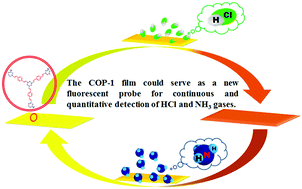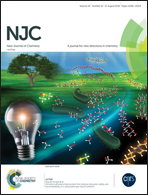Continuous detection of HCl and NH3 gases with a high-performance fluorescent polymer sensor†
Abstract
A novel fluorescent triazine-based covalent organic polymer (COP-1) sensor for HCl and NH3 gases has been designed and synthesized. Both the COP-1 powders that were dispersed in solvents and the COP-1 film that was formed on the surface of quartz sheets exhibited stable fluorescence and a sensitive HCl/NH3 response. Immersion in HCl-bubbled solvents weakens and red-shifts the fluorescence emission of the COP-1 powders, owing to a protonation-induced charge transfer (CT). Subsequent injection of NH3 into the solvents recovers the fluorescence via deprotonation. Interestingly, the microporous COP-1 film also shows a similar fluorescence response to HCl/NH3 gas, with high sensitivity and good reversibility, which suggests that it could serve as a solid-state optical probe for continuous and quantitative detection of HCl and NH3 gases. The formation of the red-shifting hydrogen bonds is found to be the origin of the response.



 Please wait while we load your content...
Please wait while we load your content...